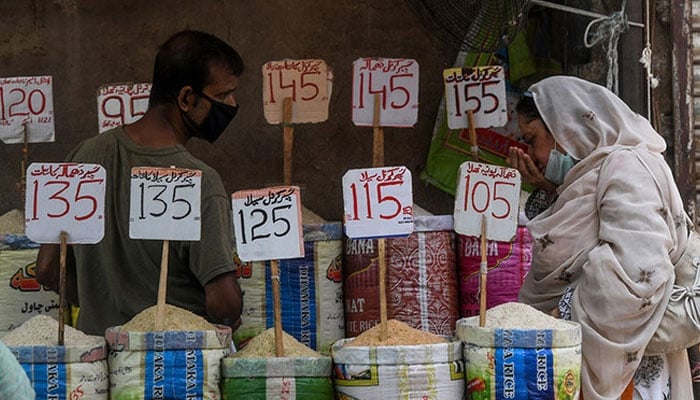SBP targets flexible inflation regime to balance prices and growth
KARACHI: The State Bank of Pakistan (SBP) said on Friday it aims to implement a flexible inflation targeting regime over the next five years, a policy framework that will help to balance long-term price stability and economic growth.
The SBP, which has been battling high inflation for the past two years, said keeping inflation within the government's medium-term target range of 5-7 percent was of utmost importance. The inflation range is one of the six goals of the SBP's 2023-2028 strategic plan, released on Friday.
"This is the first plan after revision in the SBP Act last year and thus takes into account the significantly enhanced mandate, autonomy, and accountability introduced through the changes in the Act," it said.
Pakistan has the highest inflation rate in Asia, even after a slowdown in October. The consumer price index inflation fell to 26.89 percent year-on-year in October from 31.4 percent in September.
Since September 2021, the SBP has hiked interest rates by a staggering 1,500 basis points to rein in inflation. However, since July this year, it has stopped raising rates due to signs of economic recovery and easing inflation pressures.
The SBP says price stability is the primary objective of monetary policy.
"To achieve and maintain inflation close to the government's medium-term inflation target of 5-7 percent, the SBP would further enhance the efficacy of monetary policy by implementing a flexible inflation targeting regime, improving the transmission mechanism of monetary policy, strengthening research and data management capabilities as well as identifying structural issues of Pakistan's economy and collaborating with stakeholders to address them," the central bank said in its strategic plan.
"Implement a flexible inflation targeting regime that balances long-term price stability and economic growth."
The decrease in inflation is essential to achieve sustainable economic growth, alleviate poverty, and enhance the economic well-being of the people, it added. The SBP also plans to transform existing conventional banks into Islamic banks. For this, it aims to design a roadmap for the transition towards Islamic banking and coordinate with banks for conversion to Islamic banking.
Recently, the landmark judgment by the Federal Shariat Court, requiring Pakistan's banking sector to be Shariah-compliant by 2027, has set an ambitious target for the Islamic Banking industry.
"Achieving this goal requires a well-thought-out plan and coherent actions from all stakeholders," said the SBP.
The SBP-led initiatives for Islamic banking, including the development of legal, regulatory, and supervisory frameworks and the promotion of participatory modes of financing, have increased the share of Islamic banking in the overall banking industry manifolds over the years. The market share of Islamic banking assets and deposits has reached 20 percent and 22 percent, respectively, and the number of Islamic branches has increased to 4,396 by December 2022.
The SBP Vision 2028 represents the SBP's commitment to fostering price and financial stability and contributing to the sustainable economic development of the country. The evolving risks and challenges to the economy and financial stability, including climate change, rapid digital innovations and disruptions, and growing cybersecurity threats, have also been kept in perspective while developing the plan.
The other goals include enhancing the efficiency, effectiveness, fairness, and stability of the financial system; promoting inclusive and sustainable access to financial services; transforming to a Shariah-compliant banking system; building an innovative and inclusive digital financial services ecosystem; and transforming the SBP into a high-tech, people-centric organization. These strategic goals are built to cover five cross-cutting themes, including strategic communication, climate change, technological innovation, diversity and inclusion, and productivity and competitiveness.
-
 Amanda Batula, Kyle Cooke Call It Quits After 4 Years Of Marriage
Amanda Batula, Kyle Cooke Call It Quits After 4 Years Of Marriage -
 Elijah Wood Gets Candid About Brutal 'Lord Of The Rings' Shooting
Elijah Wood Gets Candid About Brutal 'Lord Of The Rings' Shooting -
 Ellie Goulding Drops Rare Video Of Boyfriend Beau Minniear During Paris Trip
Ellie Goulding Drops Rare Video Of Boyfriend Beau Minniear During Paris Trip -
 Rihanna Hit By Hotel Door In New York, Jokes With Bodyguard Afterward
Rihanna Hit By Hotel Door In New York, Jokes With Bodyguard Afterward -
 Meghan Markle's Decision To Cut Out Raw Moment With Harry Sparks Explosion
Meghan Markle's Decision To Cut Out Raw Moment With Harry Sparks Explosion -
 Prince Harry Faces ‘massive Strain’ On His Life Due To UK Media
Prince Harry Faces ‘massive Strain’ On His Life Due To UK Media -
 Timothy Busfield Booted From Penn Badgley Starrer Rom-com After Arrest
Timothy Busfield Booted From Penn Badgley Starrer Rom-com After Arrest -
 Sydney Sweeney Racy Movie Gets Attention After 'Euphoria' S3 Trailer
Sydney Sweeney Racy Movie Gets Attention After 'Euphoria' S3 Trailer -
 Sarah Ferguson Plans To Become Meghan 2.0 And Is Preparing To Go Totally Rogue On Royals
Sarah Ferguson Plans To Become Meghan 2.0 And Is Preparing To Go Totally Rogue On Royals -
 Brooklyn Beckham Speaks Out After 'relentless Inaccuracies About Nicola': Source
Brooklyn Beckham Speaks Out After 'relentless Inaccuracies About Nicola': Source -
 Leonardo DiCaprio Steps Out With Girlfriend After Golden Globes Roast
Leonardo DiCaprio Steps Out With Girlfriend After Golden Globes Roast -
 What Nicole Kidman's New Year Will Be Like After Keith Urban Divorce
What Nicole Kidman's New Year Will Be Like After Keith Urban Divorce -
 King Charles Faux Pas That Still Makes Prince William ‘cringe’
King Charles Faux Pas That Still Makes Prince William ‘cringe’ -
 Nicola Peltz Remembers Designer Valentino After Wedding Dress Controversy
Nicola Peltz Remembers Designer Valentino After Wedding Dress Controversy -
 Amanda Seyfried Says Winning An Oscar Not A Priority
Amanda Seyfried Says Winning An Oscar Not A Priority -
 ‘Entitled’ Andrew Mountbatten-Windsor Is Still Winding People Up: ‘That’s What He’s Used To’
‘Entitled’ Andrew Mountbatten-Windsor Is Still Winding People Up: ‘That’s What He’s Used To’




